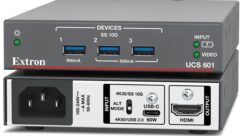

Lessons Learned In the White Spaces
When the FCC set June 12, 2010, as the deadline for vacating the 700-MHz premises, AV integrators and wireless microphone manufacturers faced a flood of new orders to swap out old 700-MHz equipment in time. Then June 12 came. And went. Little seemed to happen.
A few years ago, the federal communications Commission (FCC) began allocating spectrum in the 700-MHz wireless band for broadband services and public safety agencies, taking the so-called white spaces once used by TV stations and auctioning them off. It just so happens the 700-MHz band has been a popular one with churches, courts, performance venues, and other pro AV users who set up wireless microphone systems. After much lobbying by the AV industry and its diverse customers (NASCAR, the NFL, Harrah’s Entertainment, and even country music legend Dolly Parton were among those asking the FCC not to do what it eventually did), the FCC’s message to the AV community was clear: Get your wireless devices out of the 700-MHz spectrum—or else.
When the FCC finally set June 12, 2010, as the deadline for vacating the 700-MHz premises (originally it was set for December 2009), AV integrators and wireless microphone manufacturers faced a flood of new orders to swap out old 700-MHz equipment in time. In the months prior, manufacturers such as Shure and Sennheiser communicated heavily via their websites, newsletters, and bulletins to ensure that wireless microphone owners knew about the deadline. Most microphone manufacturers offered rebates for 700-MHz equipment that could be applied to the purchase of new systems. Users were urged to operate elsewhere, such as the TV band, which runs 470 to 698 MHz. The FCC posted a comprehensive list of banned wireless microphone models on their website. And AV integrators themselves were calling customers and informing them of the upcoming ban.
Then June 12 came. And went. Many wireless mic users were safely out of the 700-MHz band, but others weren’t. And nothing happened. Venues that still had 700-MHz wireless microphones in operation continued as usual. The only difference was, now they were breaking federal law. To this day, despite constant warnings that the FCC ban is in effect, many small businesses, houses of worship, and community theaters are still running illicit equipment. But they have their reasons.
“There are still many churches who don’t know about the 700-MHz ban,” says David McLain, an inside sales rep for CCI Solutions, a church-centric AV integrator in Olympia, Wash. “I was getting just as many calls about it at the end of June as I was a month before.” His firm has gone to great lengths to notify customers, including an ongoing effort to contact every customer who has ever purchased 700-MHz equipment from them.
When McLain speaks to a customer who is hesitant to change their systems, he informs them of the FCC’s penalties, which can amount to a whopping $4,000 per day up to $375,000. Some, he says, will send their 700-MHz systems someplace like South America on a missionary trip and the microphones will just stay there. The equipment can still operate above-board in other countries.
Déjà Vu All Over Again
In June, President Obama signed a memorandum commiting the federal government to coming up with 500 more megahertz of wireless spectrum “to foster investment, economic growth, and help create hundreds of thousands of jobs by meeting the burgeoning demand for mobile and fixed broadband,” according to a White House statement. Specifically, the memo instructs the National Telecommunications and Information Administration (NTIA) and the Federal Communications Commission (FCC) to make available 500 MHz of federal and nonfederal spectrum over the next 10 years.
This comes several months after the FCC issued its National Broadband Plan, which recommended the additional 500 MHz. Part of the process has been fast-tracked: The NTIA and FCC could determine by as early as October whether they can carve out a little fresh spectrum in the next five years.
Some in the AV industry are understandly gun-shy of the federal government honing in on spectrum after it ordered wireless microphone users out of the 700-MHz band earlier this year. Officials at Shure, which has been among the most vocal defenders of wireless spectrum for the AV industry, have already been fielding questions from worried AV pros. The upshot? There’s nothing to worry about now.
Chris Lyons, Shure’s manager of technical and educational communication, put it this way: “The timing of the President’s memo seems to have caused some confusion. The memo refers to the same 500 MHz of spectrum recommended by the FCC, not an additional 500 MHz. The 500 MHz would be made up of numerous slices in different sections of the spectrum, not a single block or a so-called ‘500 MHz band.’
“Some media stories have implied that the President’s memo makes this spectrum available immediately, which is not true. … Neither the National Broadband Plan nor the President’s memorandum changes the frequency ranges in which wireless microphones and similar products can operate. Depending on the degree to which any parts of the Plan are eventually implemented, the operating environment for wireless microphones may become more crowded in
the future.”
David Wolf, CTS-D, a systems engineer with the Whitlock Group in Richmond, Va., says, “It seems that available funds are the main issue. Some have been educated about the law, while others have not. When they are made aware of the law, they’re interested in compliance but it seems when the cost is realized—even with the [manufacturer’s] rebate—the labor and hardware are still significant.”
And even if they wanted to swap out their systems now, they could face a wait.
David Taylor, CTS, church sales manager for Ford Audio-Video Systems in Oklahoma City, Okla., works with many small churches in his region. “I’ve heard some customers say they will wait it out, even though we’ve been educating them all along about 700-MHz issues and deadlines,” he says. “Still, other customers jumped on early and got their new equipment installed in plenty of time. There was a rush to swap equipment right before the June 12 deadline, so manufacturers are now backordered. I have some clients who are using wired microphones for the next three to four weeks until they get new equipment.”
Moreover, the Harvard Law overhaul was completed in plenty of time for the June 12 deadline. “I was becoming more aware that the [digital TV] transition was coming in early 2010, and it was going to have a big impact on the wireless spectrum,” Gregoire says. “Our old 700-MHz gear was functioning perfectly, but for how long? As a law school, we felt it absolutely necessary to be legal, so we wanted to change to keep in accordance with the FCC edict.”
For Kevin Anvik, technical director of audio for the Scottsdale Bible Church in Scottsdale, Ariz., a good budget position was the primary driver in swapping out the church’s old 700-MHz wireless microphones. “We found out a few of years ago that the FCC was ruling on the 700-MHz issue. At the time, we had 10 to 12 700-MHz wireless microphones in the sanctuary plus another 16 wireless systems at our North Campus,” he says. “When the FCC had the December 2009 deadline, before it was extended to June 12, we’d changed out only a few mics. But if a switch had flipped on that date and nothing in the 700-MHz band worked, then the main users, like the pastor and his mic, were covered.”
Since then, Anvik has upgraded to higher-end wireless microphone systems in the sanctuary at a cost of $32,000. The total tally is yet to be determined, as Anvik and his team are still specifying new wireless systems for their North Campus.
Rental and staging companies also aren’t hesitating when it comes to swapping out their 700-MHz systems. “That’s because you are putting yourself and your client at risk [if you don’t],” says Keith Taylor, executive vice president of Multi Media Services in Atlanta, Ga., and member of the USAV buying group. “Rental companies have to upgrade their wireless mic systems because clients can also be fined. It’s not even a question of using illegal equipment since our job is high exposure and high liability. But small corporations don’t feel a big rush to comply. The chances of getting caught are slim but the first problem may be that their system is no longer working well due to interference. The integrity of their wireless system is in jeopardy if they don’t upgrade.”
Surprisingly, there’s a different mentality in the broadcast market, at least when it comes to independent sound recorders. “They will keep using 700-MHz wireless because they are never in the same venue for long,” says Reg Webb, co-founder of Sound Mixers in Chandler, Ariz. “These guys bought expensive equipment to do their job and their livelihoods depend on it. They can’t afford to rebuild their RF systems, so they are rebelling. Some of the higher-end equipment can get reblocked but that also costs money.”
Who else isn’t complying? Pro AV spoke to several people, but no one wanted to be identified, for obvious reasons. One technical director at a 2,000-seat church in Oklahoma who wished to remain anonymous said he regularly runs 20 wireless channels throughout the complex, of which five are in the 700-MHz band. “At one point, I was using up to 12 wireless channels at once but am now running about four channels in the sanctuary during a service,” he says. “The biggest reasons not to upgrade are that the demand is not there and that the rebate wasn’t enough to make the investment worth it now.”
He said he also won’t hesitate to use the 700-MHz wireless microphones in the future. Why? He spent six years in the fire service and works full-time for AT&T, one of the largest purchasers at the 700-MHz spectrum auction. “I know how the wireless equipment at the fire service works. My equipment has a small frequency footprint. It’s analog, and the new public safety equipment is transmitting digital data. Besides, there isn’t enough power for my mics to interfere with them. If anything, they’ll be interfering with me,” he adds.
He also points to lax enforcement by the FCC against much larger 700-MHz wireless users who would “walk all over” fire service channels. His church also doesn’t run its wireless microphones on a continuous basis. “My chances of getting caught are very slim,” he says.
A recent incident at a church in Washington shows that the FCC isn’t the only one policing the spectrum. According to several sources familiar with the incident, a Verizon representative contacted a church that was operating 700-MHz wireless microphones after June 12. Verizon’s directive: Stop or we will report you to the FCC. The church, which was surprised it got caught so quickly, is reportedly upgrading its systems.
“The FCC will look at every complaint on a case-by-case basis,” says Matthew Nodine, chief of staff for the wireless bureau of the FCC. “Penalties range from seizure of equipment, to fines or criminal penalties. It is a major concern that illegal 700-MHz equipment like wireless microphone systems will interfere with EMS, fire, or police emergency communications. This is why we are taking it so seriously. We also strongly encourage public safety agencies to talk about this issue with their county board of supervisors, school superintendents, and their local churches so they are aware of the new rules and take action to comply.”
How will the FCC know if people are ignoring the 700-MHz ban? Nodine says most likely, the evidence will present itself one of two ways. Either someone will die or become injured because a public safety system failed due to interference from an illegal 700-MHz wireless system, or companies that now own parts of the spectrum, which they purchased in an FCC auction, will file a complaint with the commission.
“700 MHz has great propagation characteristics and that’s why it was chosen as the spectrum for public safety and wireless broadband services,” Nodine says. “The FCC hopes that people will take this prohibition seriously and not operate in the 700-MHz spectrum, understanding this is a violation of federal law. It is critical that our public safety entities be able to provide life-saving services without interference.”
Laurie Webb of Sound Mixers believes the focus of compliance needs to go a step further. “As more people are corralled into the same bandwidth, the available spectrum will get more crowded. People are buying equipment in the legal spectrum range but many systems do not provide enough switching bandwidth for future congestion,” she says. “It is a difficult situation because customers don’t want to go through this again in five to 10 years.”
As a result of the potential crowding issue, Reg Webb will often go to a client site and conduct a spectrum analysis if they’re running more than 10 channels of wireless. “The greater part of the job is sorting out frequencies. The FCC says there is plenty of space for everyone, but TV receivers aren’t very sensitive. Wireless mics are much more sensitive and can pick up ‘weak’ signals that TV receivers cannot,” he says.
Webb adds, “Some customers have purchased equipment to come into compliance but, as the spectrum gets more crowded, the equipment won’t work at all. So don’t buy for today; buy for a few years from now.” AV










